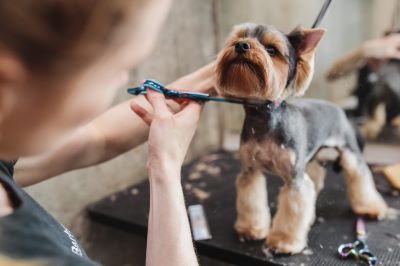Tips for grooming dogs and cats

We all want our pets to put their best ‘paw’ forward, which is why it’s essential to keep them well groomed. Regular grooming helps keep their coat clean, healthy, and shiny, and it can also help prevent skin problems and matting. It’s also a good opportunity to have a closer look at them too, to spot any issues they may have, particularly with their eyes, ears, teeth and paws. There’s more to good grooming than just brushing and bathing – it also includes claw trimming, ear cleaning and dental care too.
Claw trimming
Keeping claws the right length is important for both cats and dogs. Long claws can be uncomfortable and can even cause pain to your pet when they walk.
To trim your pet's claws, use a pet-specific clipper and make sure to only trim the tip of the claw. Avoid cutting the quick, which is the pink part of the claw that contains blood vessels and nerves. If you accidentally cut the quick, it can cause bleeding and pain. Ask your vet if you’re unsure or YouTube can be a great source of information if you need a visual guide to help you find the quick on your pet, which can be difficult if they have dark-coloured claws.
Ear cleaning
Cleaning your pet's ears can help prevent ear infections and keep their ears smelling fresh. Use a cotton ball or soft cloth and a gentle, pet-specific ear cleaner. Don’t use cotton swabs, or push anything into their ear canals as this can push debris deeper into the ear canal.
Gently wipe the inside of your pet's ear flap and the ear canal opening. If you notice any redness, swelling, or discharge, contact your vet as these can be signs of an ear infection.
Dental care
It’s important to look after your pet’s teeth. Dental problems can cause pain, bad breath, and even systemic infections. You can help keep your pet's teeth clean by brushing them regularly with a pet-specific toothbrush and toothpaste.
Your cat or dog may not be comfortable with tooth brushing at first, so start slowly and gradually. Offer them a taste of the toothpaste and let them sniff and explore the toothbrush. Once they’re comfortable, gently lift their lip and brush their teeth in a circular motion. If you’re finding it difficult to brush their teeth contact your vet or a groomer for advice.
Do they need a haircut?
If your cat or dog has medium to long hair, they may need the occasional haircut or trim, just to keep them looking and feeling good. If you plan on trimming your pet’s hair yourself, remember to use blunt-ended scissors to avoid injury if your pet makes any sudden movements. Ideally, you should take your pet to a groomer for a haircut, just so you can be sure that it’s done properly and safely.
If your pet doesn’t enjoy the fuss that comes with grooming, keep some treats on hand to reward them for their patience. And remember to introduce them to grooming as early as possible when they’re puppies and kittens, so that they become comfortable with it and know it’s just a normal part of their routine.
